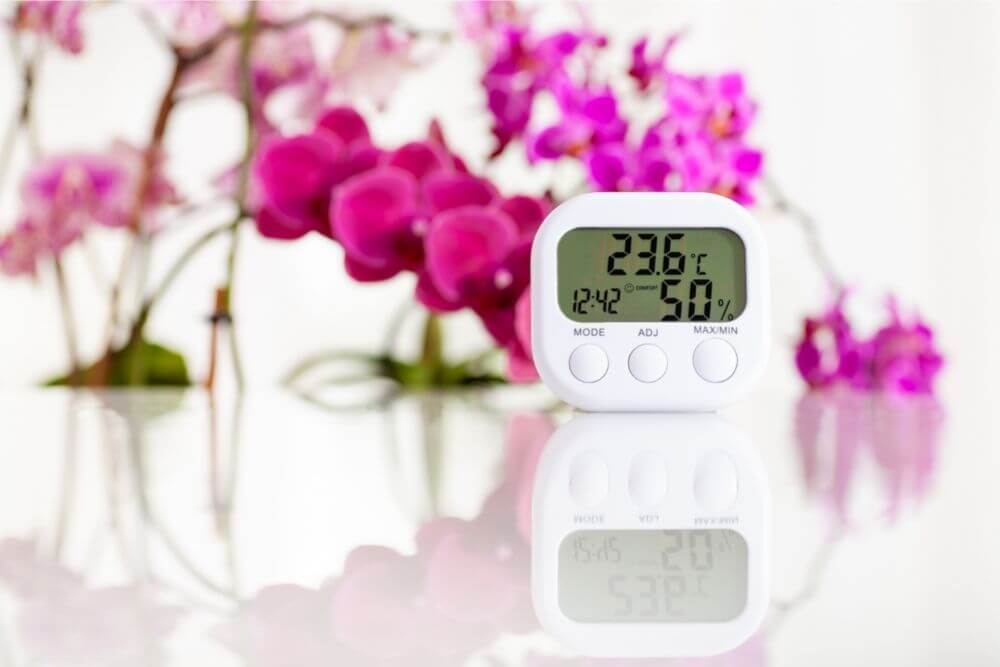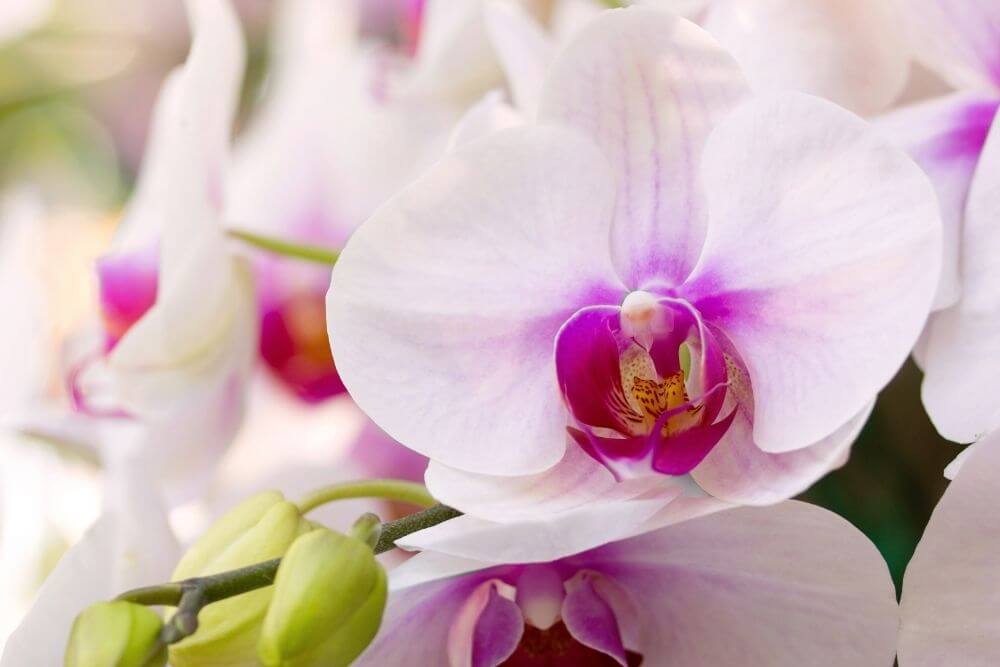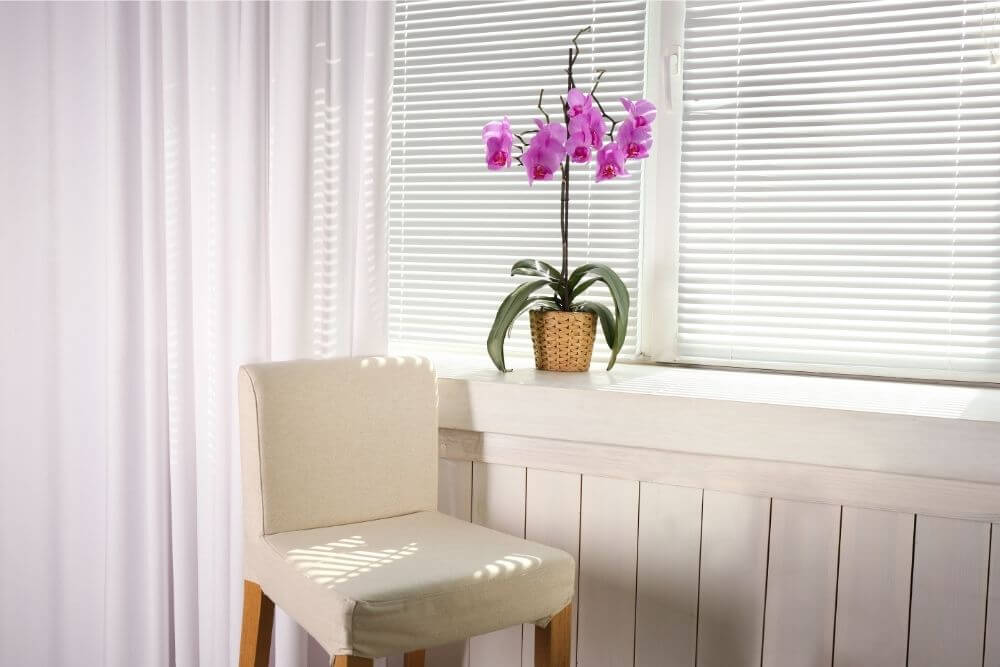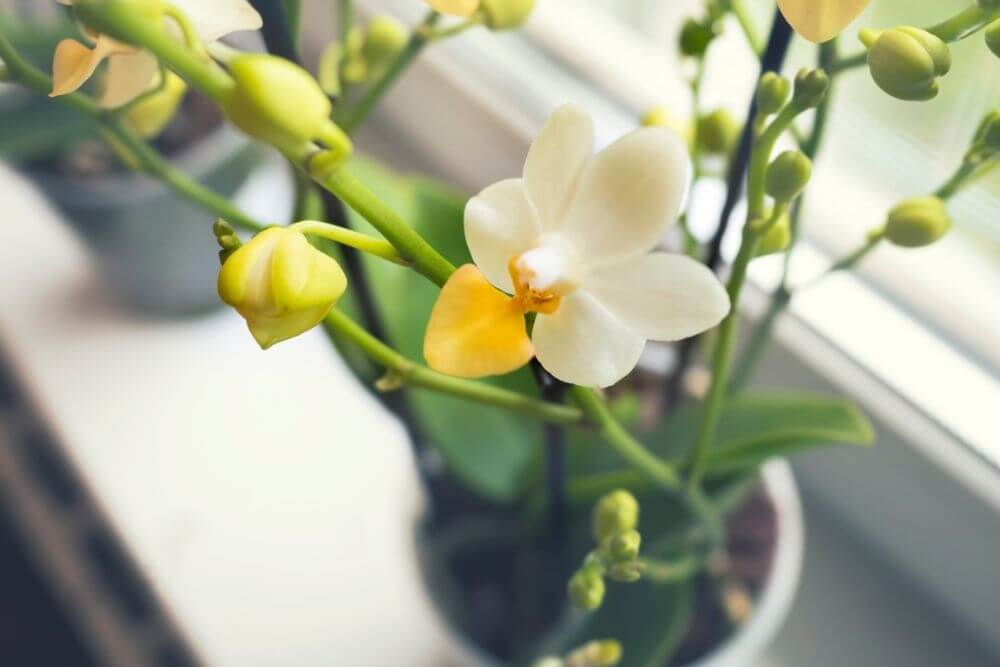Orchids decorate many windowsills, they are one of the most popular houseplants in this country. The noble flower is not always easy to care for. There are some things to consider, among other things, the right location should be well selected. So the question arises in winter: Can orchids stand above the heating?
Orchids need high humidity, dry heating air is not optimal for the plants. Nevertheless, most species of orchids can stand above the heater, provided that you provide a suitably high humidity.
That was just the short answer to the question. Together we will find out in which places orchids feel most comfortable and what else you should consider when caring for them.
Contents
- 1 Putting orchids above the heating
- 2 Why cultivate orchids above the heater?
- 3 The optimal humidity for orchids
- 4 Control humidity
- 5 Regulate humidity above the heater
- 6 How warm should orchids be placed?
- 7 How much light do orchids need in winter?
- 8 Where do orchids feel most comfortable?
- 9 Where are orchids best in winter?
- 10 What do orchids not like?
- 11 Author
Putting orchids above the heating
There are more than 30,000 different species of orchids and not all species are suitable for indoor growing. Some more demanding species feel comfortable only in special greenhouses with precisely regulated temperature and humidity.
The best known and most popular orchid species are not quite so demanding, but there are some things to consider when caring for them in winter. Again, the different species differ in their requirements for an ideal environment.
Why cultivate orchids above the heater?

Orchids need enough light, especially in winter. Thus, the window sill is the perfect place for orchids, because the light conditions are usually good there.
However, in most window places, the heater is located directly under the window sill. Therefore, the question arises whether orchids can be placed above the heater.
The place directly above the heater is not ideal, because the dry heating air is not good for the plants.
After all, the decorative plants are native to the rainforest. There, in addition to warmth and fresh, clean air, they are used to a lot of moisture.
However, you can still cultivate most types of orchids in winter above the heater, as long as you provide an appropriately high humidity.
The optimal humidity for orchids
Due to the constant rainfall and sunshine in their native habitat, orchids feel most comfortable in a warm, humid climate.
If your orchids are placed above the heater during the winter, this can quickly cause the orchid substrate to dry out. So, you should make sure to water your plants at shorter intervals.
Control humidity
With the help of a hygrometer, you can keep an eye on the humidity near the plants. Such a meter is not very expensive, but extremely helpful in creating an optimal indoor climate for tropical beauty.

Most orchid species are most comfortable at humidity levels between 50 and 60 percent. If the humidity is too low, the roots dry out quickly and the leaves become limp. If humidity is too high, plants are susceptible to bacterial or mold growth.
Regulate humidity above the heater
Not only can low humidity be harmful to orchids, but it can also cause various health problems for us humans. Dry heating air, for example, can attack our mucous membranes and germs can spread more easily.
There are some measures you can take to increase humidity levels that are too low:
- Spraying the orchid leaves with water – probably the simplest method is to spray the orchid leaves with a little lime-poor, lukewarm water. You should not wet the flowers in the process, as they could fall off very quickly. Also, you should not overdo it with dusting, as too frequent spraying could promote fungal diseases. Two to three times a week should be enough.
- Use of water bowls above the heater – also a simple variant is to fill a small bowl with some water and place it on the window sill next to the orchids. Water bowls on or near the heater can also help with excessively dry heating air. The evaporating water can help raise the humidity a bit.
- Dry laundry near the plants – drying wet laundry in the room where the plants are located not only saves energy costs, but can also provide a more humid climate in no time.
- Humidifiers with adjustable humidity – for those who like convenience, an electric room humidifier can provide the ideal orchid climate. These devices often allow you to precisely regulate the desired humidity. Be sure to clean the humidifier regularly, otherwise they can turn into germ havens. You should also pay attention to the volume when buying. Some devices can get very loud, while others are whisper quiet.
- Fill saucers with expanded clay and water – Expanded clay can provide the ideal humidity in winter. To do this, simply put some expanded clay and water in a saucer and place the orchid on it. Only fill with enough water to prevent the orchid’s roots from drawing water.
- Signs of too low humidity
- Often too dry room air manifests itself in brown tips on the leaves. Later, the leaves become limp and fall off. Prematurely falling buds and flowers can also be a sign of too dry indoor air.
Unfortunately, once the leaves turn brown, they will not recover. You should cut the leaves off with disinfected scissors so that the orchid can use its strength elsewhere.
How warm should orchids be placed?
Not only humidity is crucial for optimal care, you should also pay attention to the right room temperature. When it comes to the ideal temperature, the most popular orchid species differ fundamentally in their requirements.

Temperatures in winter should generally be lower than in summer. Here is a list of winter temperatures for the most popular orchid species:
- Ascocentrum 17-22 °C
- Cattleya 18-20 °C
- Cymbidium 15-18 °C
- Dendrobium 20-25 °C
- Miltonia 15-18 °C
- Phalaenopsis 15-25 °C
- Odontoglossum 12-22 °C
- Oncidium 15-18 °C
- Vanda 17-22 °C
In general, the temperature should be slightly lower at night than during the day. It is therefore advisable to turn off the heating overnight. This is not only good for the orchids, but also saves heating costs.
For rarer orchid species, it is also advisable to get more information, for example, on Internet forums or from technical literature.
How much light do orchids need in winter?
In general, orchids need plenty of light to develop their full flowering splendor.

In winter, when the sun shines shorter, bright light is especially important for the plants. Therefore, a bright location by the window should be chosen.
For rather dark locations, a special plant lamp might be suitable. It is very important that the lamp covers all spectra of the necessary light. Especially important is the light in the range of photosynthetically active radiation (PAR). This is how you keep photosynthesis going even in the dark season.
There are now very good LED lamps that are not only inexpensive to buy, but also require less power than conventional plant lamps.
Where do orchids feel most comfortable?
Orchids prefer bright locations. However, care should be taken to ensure that the plants do not receive too much sunlight.
Especially in summer, east or west windows are best suited. South windows are not suitable because of the strong sunlight. If you still prefer to see your orchids in the summer at the south window, then please ensure the necessary protection, for example, by a light curtain.
Where are orchids best in winter?
In winter, the south window is ideal as a location, but from March onwards, the plants should again be protected from the blazing sun.
What do orchids not like?
Orchids need plenty of tact, especially in winter. In addition to a bright location and sufficiently high humidity, there are a few things to consider.
For example, you should protect your orchids from cold drafts in winter, because these tropical plants do not tolerate them at all.
Also, you should almost completely abandon fertilizer in the winter. Orchids are in growth from spring to autumn. In winter, they usually go dormant. You can recognize this by the flower shedding, it ends with the first new shoots in spring.
It is not quite easy with an orchid in the winter, but plant lovers should not despair. If you pay attention to the temperature, humidity, and brightness, then the beautiful plants will get through the dark season well.


